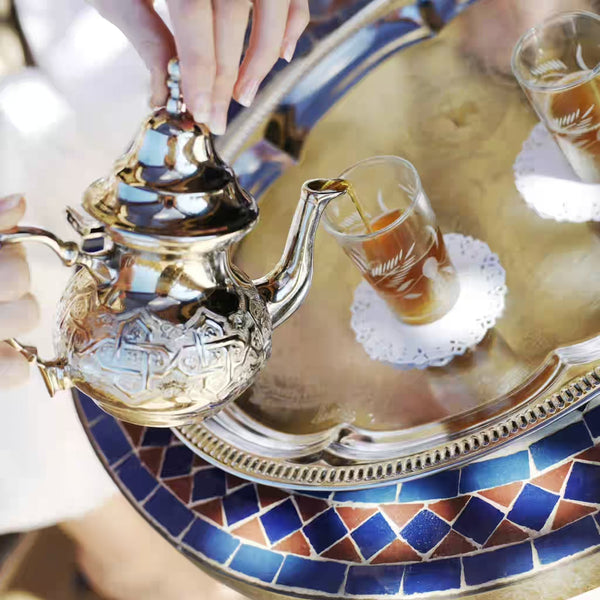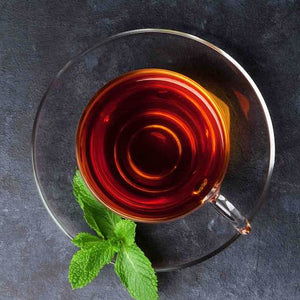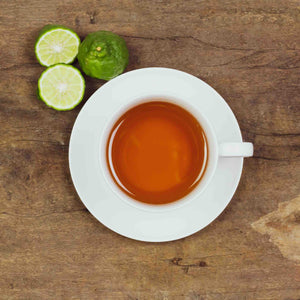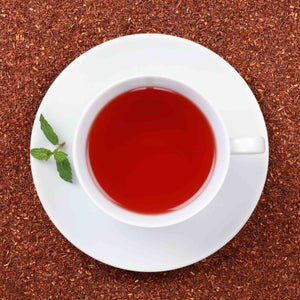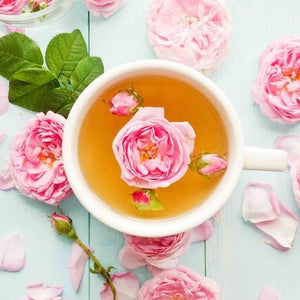Atay | The Story of Moroccan Tea
May 23, 2025
Moroccan Tea | A Contested History
Introduction
Few beverages carry as much cultural weight in Morocco as Atay. More than just a drink, Moroccan Mint Tea is a daily ritual — an art form performed with practiced grace, a symbol of warmth, generosity, and national pride.
But while Atay feels timeless, its history is anything but straightforward. How and when did tea arrive in Morocco? And how did it become such an essential part of everyday life — from the desert tents of the Sahara to the cafés of Casablanca?
What follows is a closer look at the long, surprising journey of tea in Morocco — one that challenges some of the most common assumptions.

The Origins of Moroccan Tea? It’s Complicated.
The dominant narrative, repeated endlessly, claims that tea arrived in Morocco via British merchants in the 18th or 19th century — a colonial import, little more than a foreign commodity served on a silver platter. But this version of events, while convenient, flattens centuries of layered history and overlooks deep-rooted regional dynamics. Long before the colonial era, tea — or Atay — was already steeped in cultural practices across North Africa and the Arab world.
In reality, Morocco was never isolated from the global flows of goods and ideas. During the Islamic Golden Age, extensive maritime routes connected China, the Middle East, and the Maghreb, allowing not only the circulation of commodities like tea, but also the movement of botanical knowledge, spiritual practices, and dietary traditions. Medieval Arab scholars referenced tea in medical and botanical treatises, while trans-Mediterranean trade routes ensured its diffusion.
Some linguists trace the Moroccan word Atay back to the Arabic atâ, meaning “gift.” Others point to its southern Chinese origins, arriving via maritime routes that brought tea to North African shores long before European merchants cast anchor.
The question of tea’s origins in Morocco is more than an academic detail. It is part of a broader struggle over cultural memory and historical agency. Moroccan historian Abdelhak Sebti, for example, argues that the tea ritual only fully emerged under colonial rule. It’s a view worth considering, but one that risks sidelining pre-colonial agency and the creative adaptations of local communities who adopted and transformed tea into something uniquely their own.
To ignore that legacy is to miss a fundamental piece of Maghreb identity — and to continue privileging Eurocentric stories that underestimate the intellectual and cultural contributions of the region.
At Maison NANA1807, we believe tea in Morocco is more than a drink. It is a living heritage — one shaped by centuries of trade, spiritual practice, and social ritual. It is an act of memory, resistance, and hospitality.
A Multi-Secular Trade Network
Contrary to the standard narrative, tea didn’t just arrive in Morocco with British merchants in the 18th century as a luxury good for colonial elites. It was part of a complex web of trade that had long connected the Islamic world to Asia and beyond. From the 9th century onward, tea traveled alongside silk, spices, and texts — across oceans, deserts, and dynastic borders.
Its spread was not merely commercial. In the Islamic tradition, where cleanliness, herbal medicine, and perfume occupy central places, infusions like tea were quickly embraced. They became part of a holistic lifestyle that joined spirituality, health, and conviviality. In this sense, Moroccan tea culture didn’t just adopt tea — it adapted and reimagined it through local values and everyday practice.
Today, Moroccan tea stands as a symbol not only of national pride but of cultural resilience. It is no longer an exotic import but a ritual of belonging — steeped in centuries of transformation.

The Rise of Moroccan Tea | A Blend of Influences
The combination of green tea—often Chinese gunpowder—and fresh mint wasn’t an inevitable tradition but a cultural innovation shaped over time. Several factors drove this fusion: the abundance of mint growing in Moroccan gardens, the region’s hot climate making the refreshing infusion particularly welcome, and the art of hospitality that celebrates sharing a fragrant, carefully prepared drink.
It was likely in the 19th century, amid the expansion of European-influenced import routes, that mint tea as we know it spread widely across Morocco. Yet, this was not mere submission to colonial influence—it was a vibrant act of cultural reappropriation. Moroccans, especially women, played a pivotal role: codifying the ritual gestures, passing down recipes, and transforming a simple brew into an expression of care and love.
This tradition is far from static; it remains a living practice, constantly reinterpreted across regions like the Rif, Middle Atlas, or Souss, each adding unique touches—varying sweetness, different levels of mint, and sometimes absinthe, verbena, thyme, or sage. This diversity reflects Morocco’s rich terroir and the inventiveness of its people.
Moroccan Tea | Heritage, Pride, and Cultural Diplomacy
Today, the Moroccan tea ceremony extends well beyond the family home. It captivates international audiences, serving as a cultural diplomacy tool and a symbol of peace, hospitality, and refinement. Recognized as intangible cultural heritage, the ritual carries memories of ancient exchanges and a powerful message of coexistence grounded in respect, generosity, and the beauty of shared gestures.
Through its tea collections and cultural projects, Maison NANA1807 seeks to preserve and modernize this legacy. Every cup of Atay served in our tea salons or during events like “Mint Tea for Peace” embodies this multifaceted history—spanning Africa, the Mediterranean, and Asia.
Valuing Moroccan tea means honoring the creativity of Global South societies—their ability to absorb, reinvent, and pass down traditions beyond reductive narratives of dependency or colonial import.

Colonial Impact | Allure of “Modernity”
The influence of colonialism on the contemporary form of Moroccan tea should not be underestimated. The widespread introduction of sugar and the mass commercialization significantly altered both the taste and the cultural practice surrounding tea. Yet, this “modernization” represents a dual dynamic: it reflects European economic dominance while also showcasing the local population’s ability to reinterpret and make the tea a marker of their identity.
Historians like Abdelhak Sebti emphasize this colonial role, but focusing solely on that risks overshadowing the richness of internal cultural dynamics. Moroccan tea is thus a hybrid product—born from a tangled history marked by domination and resistance, commerce and culture, early globalization and local heritage.
Tea Culture | Memory and Stakes
Today, this contested history of Moroccan tea plays out in cultural and political arenas. Valuing tea traditions through initiatives like those of Maison NANA1807 is not about idealizing the past. It is a political act—rejecting simplistic narratives and reaffirming a plural identity shaped by centuries of exchanges and cultural appropriations.
In a globalized world where local know-how is often marginalized, defending Morocco’s rich tea heritage is also a fight for recognition of a multifaceted history—one of openness, blending, and creativity. It is a refusal to let the past be reduced to a mere footnote of colonial history.
Origins of Moroccan Tea | Ancient Networks
Long before the rise of European colonial powers, Morocco occupied a strategic crossroads of Mediterranean, Saharan, and Muslim trade routes. While tea’s origins are indisputably Chinese—consumed since the Shang dynasty around 1500 BCE—its arrival in the Maghreb is part of the thriving maritime and overland networks of the early Islamic world.
By the 7th century, Arab and Muslim merchants dominated commerce across the Indian Ocean, Red Sea, and Mediterranean. They connected distant regions—China, the Arabian Peninsula, East Africa, and the Maghreb—creating a web of exchanges carrying not only goods but also ideas, knowledge, and cultural practices. The work of historian Xinru Liu in The Silk Road in World History (2010) highlights how tea and medicinal plants were key commodities in these flows.
Morocco’s contact with Arabia and the wider Muslim world thus facilitated tea’s introduction as early as the 9th century. Ancient Arabic medical texts and travelers’ accounts attest to the use of tea and herbal infusions. Ibn Battuta (1304–1369), the famed Moroccan traveler and scholar, described widespread tea consumption throughout the Islamic world, including the Maghreb, emphasizing its medicinal and social uses.
Linguistically, the Moroccan term Atay (أتاي) derives from the Min dialect word “te” from southern China, distinct from the “cha” used in northern China. This etymology mirrors the maritime trade routes where Arab-speaking merchants adopted and spread the term across the Maghreb.
Contrary to popular simplifications that claim tea was introduced en masse to Morocco only with British imports in the 18th and 19th centuries, evidence shows that tea culture had been developing for centuries. At that time, tea was sometimes consumed with mint but often without sugar—the widespread addition of sugar only took hold in the 20th century, a direct consequence of the colonial sugar industry imposed by the French Protectorate.
Arab merchants and Muslim scholars played a central role in facilitating this early tea trade. Alongside spices, incense, and textiles, tea was among the botanical products transported along vast trade arteries connecting East Asia to the Maghreb. Meanwhile, trans-Saharan routes carried gold, slaves, and horses—highlighting the complexity and wealth of the economic networks in which tea was deeply embedded.
Thus, tea transcends its simple role as a beverage: it symbolizes cultural and economic interdependencies across continents and lays the foundation for a ritual that remains essential to daily Moroccan life—the preparation and sharing of Atay.

Tea | A Ritual and Remedy in the Muslim World
Tea, far from being just a commercial commodity, quickly became a medicinal and cultural staple in the Muslim world. From the 7th to the 14th century, Muslim scholars produced extensive writings on medicinal herbs and botanical infusions, recognizing tea alongside other aromatic plants for its stimulating and healing properties.
One of the most influential figures was Avicenna (Ibn Sina, 980–1037). His seminal work, The Canon of Medicine (Al-Qanun fi al-Tibb), brought together Greco-Roman, Persian, and Indian medical knowledge within an emerging Islamic medical framework. Although tea was not yet widespread in his time, Avicenna’s categorization of medicinal plants set the stage for tea’s eventual integration into Arab medicine.
By the 10th century, Islamic medical encyclopedias and botanical treatises began to mention tea explicitly. Drawing heavily on Chinese pharmacology, scholars like Al-Razi (865–925), based in Baghdad, and later Ibn al-Baytar (1197–1248), documented the properties of various plants, including teas prized for digestive, stimulating, and calming effects.
Tea culture was also shaped by travelers and merchants who spread knowledge and customs across regions. Ibn Battuta, the famed 14th-century explorer, describes tea consumption stretching from the Levant to the Maghreb, highlighting its dual role in social interaction and health.
Meanwhile, the formal tea ceremony codified in China during the Tang dynasty — especially through Lu Yu’s Cha Jing(The Classic of Tea) around 760 — indirectly influenced Islamic tea culture. Though no medieval Arabic translations survive, oral tradition and trade routes carried the idea of tea as both a refined social drink and a medicinal infusion.
In Morocco, these ancient influences gave rise to the Atay ritual: a blend of Chinese tea leaves and local mint, sometimes enriched with other herbs. The custom of pouring tea from a height into small glasses to create a frothy head reflects longstanding hospitality codes and a shared focus on health and community well-being.
Tea, then, was never a passive import but a dynamic cultural and medical element — integrated deeply into Islamic botanical medicine, social rituals, and Moroccan identity.
Tracing “Atay” | From China to Morocco
The Arabic word Atay (أتاي), commonly used in Morocco to mean tea, carries centuries of cultural and linguistic exchange along ancient trade routes linking China, Arabia, and North Africa. Understanding its etymology reveals more than just the history of a product — it’s a story embedded in language and identity.
Tea originated in China millennia ago, with two primary pronunciations:
-
Cha (茶), prevalent in northern and central China,
-
Te (pronounced “tay” or “teh”), used in southern coastal regions like Fujian and Min.
This distinction matters. The term te entered European languages through maritime trade routes established by the Dutch and Portuguese in the 16th century, explaining why English, French, and Dutch use variants of “tea.”
Conversely, the Arabic Atay derives from this southern Chinese pronunciation, introduced to the Muslim world by Arab maritime traders active along the Indian Ocean and South China Sea from the early Middle Ages. Unlike the overland Silk Road, which spread cha to Persian, Turkish, and Russian languages (as chai), maritime routes brought te into Arabic and later Berber and Moroccan dialects.
Historical evidence confirms Arab merchant communities in Chinese port cities like Guangzhou and Quanzhou controlled much of the maritime trade from as early as the 7th century (Dreyer, 2007). These Muslim enclaves served as cultural and commercial bridges, introducing tea and its terminology into the Islamic world and beyond.
Morocco’s adoption of Atay reflects this layered heritage — a fusion of Chinese linguistic roots and Arabic phonetic adaptations woven into the region’s cultural mosaic. This challenges the mistaken belief that Moroccan tea culture arose solely from massive British imports in the 18th and 19th centuries, showing instead a far older integration.
More than a word, Atay has evolved into a powerful symbol of Moroccan hospitality and identity — representing a unique tea ritual centered on mint, community, and tradition.

Origins of Moroccan Tea | Myths and Realities
Moroccan tea culture, world-renowned for its distinctive preparation and social significance, is often surrounded by widespread misconceptions—frequently incomplete or simply wrong. Unpacking these myths helps shed light on the true historical roots of Moroccan tea and honors its rich multicultural heritage.
Myth 1 | Introduction of Tea to Morocco
Did the British bring tea to Morocco in the 18th or 19th centuries?
A common belief holds that tea arrived in Morocco solely through British colonial trade during the 18th or 19th centuries. While it’s true that the British expanded tea imports on a large scale during that period, archaeological and textual evidence shows that tea consumption in Morocco dates back much earlier.
Historical sources confirm that tea was already known throughout the Muslim world, including the Maghreb, as early as the 9th century—introduced by Arab and Muslim merchants active across trans-Saharan and Indian Ocean trade networks (Liu, 2010; Benn, 2015). These traders brought not just goods but also knowledge of tea’s medicinal and cultural benefits, long before European commercial intensification.
Myth 2 | The Moroccan Tea Ritual
Is Moroccan Mint Tea a recent colonial invention?
Some accounts present the mint tea ritual as a modern creation, entirely shaped under colonial influence. In reality, mixing tea leaves with fresh herbs like mint reflects centuries of local adaptation and creativity.
Tea’s presence in Morocco in the 9th century predates the widespread availability of sugar, which only became common with French and Spanish protectorates in the early 20th century. Before that, tea was traditionally consumed plain or with herbs—highlighting indigenous roots focused on flavor and medicinal virtues rather than colonial habits (Sebti, 1992).
Myth 3 | The Route of Tea to Morocco
Did tea primarily travel via the overland Silk Road?
Although the overland Silk Road played a key role in East-West exchanges, the linguistic and cultural diffusion of tea in Morocco aligns more closely with maritime routes and Arab trading networks. The Arabic word Atay itself derives from the southern Chinese pronunciation “te,” pointing to a transmission through maritime channels controlled by Arab-Muslim merchants, rather than the northern land routes that spread “cha.”
Maritime trade across the Indian Ocean—linking China, Arabia, and East Africa—was critical in introducing tea early into the Maghreb (Dreyer, 2007; Waters, 2012).
Myth 4 | Moroccan Tea’s Medicinal Uses
Did medicinal use of Moroccan tea arise only after European influence?
Contrary to this notion, Islamic scholars and physicians from the 7th to the 14th centuries incorporated tea and herbal infusions into their pharmacopoeias. The stimulating, digestive, and calming effects of tea were well recognized long before European scientific interest (notably in Avicenna’s Canon of Medicine and the botanical treatises of Ibn al-Baytar).
These medical traditions significantly contributed to embedding tea in everyday life and social rituals across Islamic societies—including Morocco.

Why Correct These Myths?
Correcting these misconceptions is essential to recognizing Moroccan tea culture as an organic, centuries-old tradition shaped by global exchanges, local innovations, and a rich Islamic scholarly heritage. This nuanced understanding deepens appreciation for the authenticity of Moroccan tea, moving beyond the simplistic narratives inherited from the colonial era.
For enthusiasts and scholars alike, grasping this complex history enriches every glass of Atay served with mint and hospitality—a drink that truly connects continents, centuries, and cultures.
Atay, Moroccan Tea | Symbol with a Millennial History
The story of Atay—Moroccan tea—is far older, more complex, and more deeply rooted than commonly assumed. Long before colonial times, tea arrived in Morocco via maritime routes linking China, the Arabian Peninsula, and the Maghreb, notably through Muslim merchants as early as the 9th century.
The word Atay, borrowed from the southern Chinese word te by Arab traders, embodies this early transmission through the Indian Ocean and underscores the central role of Islamic civilization in major historical commercial and cultural exchanges. Far from a recent invention, the Moroccan ritual of brewing green tea with fresh mint—originally without sugar—belongs to a millennial tradition shaped by local tastes, natural resources, and a distinct cultural identity.
Placing Moroccan tea in this context allows for a fuller appreciation of its richness: each cup becomes an act of remembrance, a transmission across continents, generations, and civilizations. Drinking Moroccan tea is, in essence, drinking history—a living story, shared and deeply meaningful.
